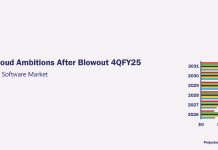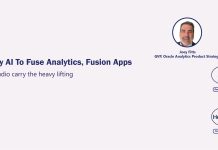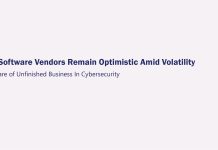The Oracle Open World conference was a showcase of the vendor’s latest database technologies and Cloud applications innovations with few surprises, but a number of key questions left unanswered as well.
There were few surprises because Larry Ellison, founder and chief technology officer, had already preannounced 18c, the focal point of OOW, two weeks earlier at its headquarters in Redwood Shores.
Slated to ship in December 2017, the 18c Autonomous Database represents another major milestone for the database market leader, delivering what promises to be a high-water mark in self-driving database technology.
Database Utility Model
“The system never comes down and it patches itself in a fraction of a second,’’ states Ellison. At a time when cybersecurity is a growing concern among enterprise customers, the coming of 18c could be a game-changer with its high-performance, security and multitenant support, real application clustering, disaster recovery capabilities, all the while running and maintaining the database without manual intervention.
On top of that, the 18c’s guaranteed 99.995% availability is half the cost of its Cloud competitor Amazon Web Services, according to Oracle. Oracle’s on-premise software revenues continued to grow, rising 2% in its latest quarter ended August 31. Database represents the bulk of such revenues and Ellison maintains that its database support revenues, the cash cow of Oracle, will continue to grow even when many of its customers migrate to the Cloud.
The reason is that Oracle is launching two pricing options – Bring Your Own License and Universal Credits – that make it easier than ever to buy and consumer Oracle databases as well as an array of options like Disaster Recovery, Analytics and Middleware – and apply them to their Oracle Cloud environment. The more database workload customers are going to migrate to the Cloud, the more licenses they have to purchase, in addition to the options needed in order to run them effectively and seamlessly in the Cloud, resulting in additional support revenues for Oracle.
When a customer brings its current $1 million database license to the Oracle Cloud, chances are it will pay another 10% to 20% in additional licenses and options, resulting in corresponding increases for maintenance revenues.
The coming of 18c underscores Oracle’s ability to reframe the database management issue by eliminating the human factor in managing the databases, thus making it more secure, less error-prone, next to zero downtime and still cheaper than something like Aurora and Redshift from Amazon, which Ellison calls them poor substitutes for top-selling databases like Oracle, Microsoft SQL and IBM DB2 because of Amazon’s reliance on outdated open-source technologies.
The question is what would happen to hundreds of thousands of Database Administrators (assuming at least one DBA for each of its 250,000+ Database customers) toiling away silently at many Oracle shops. In one of the slides provided by Thomas Kurian, president of Oracle, ongoing maintenance costs – primarily in the forms of DevOps and DBA costs – for Oracle PaaS including Oracle Database As A Service, would drop by 66%, compared with those for onpremise implementations of Oracle Database.
This is the new reality in the enterprise space as companies are migrating to the Cloud by not just adopting Cloud services, but also streamlining or closing their own data centers, a trend highlighted by Oracle CEO Mark Hurd in his keynote. Our research shows companies like Zurich Insurance aims to keep as few as eight data centers worldwide by end of 2019, compared with 70 in 2015, because they see few reasons to run their own data centers with the advent of AWS, Microsoft Azure and Oracle Cloud Infrastructure.
What this entails is that as Oracle scales out its data centers around the world, its service-level agreement calls for guaranteeing customers always-on access to their Oracle database and applications in the Cloud by delivering 18c-based systems that automate most, if not all, maintenance and administrative functions.
In such scenarios, reskilling DBAs will be an important step for the vendor to ensure its ecosystem stays vibrant by continuously reinventing itself despite the rise of AI, robots, and autonomous technologies.
Oracle’s Cool Branding
One of the ways to reskill and upskill these DBAs is through the new Startup Ecosystem and Accelerator program, which aims to attract 80 startups this year in nine cities including Bangalore, Paris, Sao Paulo, and Singapore by providing them with business tools, marketing and branding assistance and R&D subsidies such as free access to Oracle PaaS for six months.
The highly-selective program, which has attracted over 3,000 applicants since its debut in April 2016, covers six months of mentoring by tapping into the vast resources of Oracle around the world as well as its network of investors.
For example, 3D Signals in Israel is part of the Oracle Startup program with a goal to disrupt the Internet of Things with real-time condition monitoring by making sensors that detect sound irregularity in far-flung places such as an oil field.
For now, many of these startups are not even embedding Oracle technologies into their product offerings except the fact that they can use Oracle Platform As A Service and Oracle Cloud Infrastrucutre to run their operations.
Instead of spending millions or billions on new acquisitions, a practice that Oracle has deployed repeatedly in the past 12 years, the database market leader is now investing a fraction of that on making its PaaS and OCI widely available to a crop of promising startups that could yield significant returns for Oracle in the long run.
The developer/startup push is similar to what other platform vendors have launched to drive greater market penetration through their loyal supporters that have a vested interest in tying the platform they adopt to their own success. Microsoft has established an ecosystem with 750,000 partners including many ISVs around the world. Salesforce has done particularly well with its developer ecosystem attracting a sizable following under different programs such as AppExchange and Trailhead over the past few years.
For years, Oracle has proven its uncanny ability to incorporate its acquisitions into its massive organization, while driving considerable synergy across different product lines. This time, the question is whether Oracle, which has cultivated a stable set of developers such as Comarch, Manhattan Associates and Ranzal, is capable of channeling the behavior of startups and developers to help expand Oracle PaaS and IaaS even though Oracle has no ownership in these firms that have limited operating history. That job has fallen on Reggie Bradford, a three-time entrepreneur including a stint as the founder of Vitrue acquired by Oracle in 2012. As Oracle’s Senior Vice President heading up the startup program, Bradford said the priority is to democratize the Oracle brand by helping these firms get up and running quickly by leveraging the Oracle Marketplace in order to sell into the enterprise space.
On the developer side, Oracle is recruiting a number of influencers to help cement the vendor’s reputation as the force to be reckoned with in the Cloud, in addition to fostering close ties with the developer community by engendering openness and ease of doing business with Oracle.
While Oracle may be close to perfecting the Database Utility model with 18c, it’s going to take considerably more time to inject coolness to the Oracle brand before startups and developers given that it has largely kept its distance from the consumer tech space. Still, Bradford said Oracle is committed to investing heavily over the next four years to make sure its positioning resonates with the startup and developer communities.
Apps Ambitions
There were no shortages of apps news at OOW as Oracle stayed buzzword-compliant by announcing a smattering of As A Service offerings covering Blockchain, Big Data, Artificial Intelligence, and IoT Cloud applications for asset and fleet management, factory and production monitoring and industrial workforce management.
Oracle also unveiled four new products for Oracle HCM Cloud including Sourcing, Recruiting & Onboarding; Governance, Risk & Compliance; My Volunteering; and Employee Health & Safety. The talent acquisition upgrade promises to be the first product set to remake the Taleo offerings purchased back in 2012. By rewriting Taleo to run on top of Oracle HCM Cloud, the vendor has added bells and whistles from chatbots for job candidates to proactive marketing for recruiters. In fact, Gretchen Alarcon, group vice president of Oracle HCM Strategy, said by zeroing in on better candidate experience for anyone using HCM Cloud, the vendor has raised the bar for talent acquisition.
Oracle ERP Cloud, Oracle CX Cloud Suite and Oracle SCM Cloud have gone through similar upgrades with new features from more localizations to expanded industry coverage for ERP as well as full-blown maintenance, warehouse and quality management for SCM. For CX, Oracle continues to differentiate itself by emphasizing its Data As A Service. President Kurian states Oracle Data Cloud with five billion end user profiles has vaulted the vendor to become the world’s third largest data provider, trailing just behind Facebook and Google. That allows its users to gain better insights across the customer engagement process and through the CX journey.
During OOW Financial Analyst Meeting, Ellison said the ideal scenario is for existing on-premise applications customers to cease using their current systems such as Oracle E-Business Suite(EBS) and effortlessly migrate to Oracle ERP, HCM, SCM Cloud, etc., for these added benefits.
Despite such nudging and cajoling, customers continue to invest in their on-premise applications. One of the last OOW sessions attracted a couple hundred EBS customers crowding into a small open-air meeting space to fire questions at Cliff Godwin, the Oracle senior vice president who runs EBS development. The range of questions, which filled two whiteboards, covered everything from why the large one-off fix patches to mixed messages from Oracle’s inside sales unit called Oracle Digital on whether further Cloud migration for current Cloud users, vs. on-premise customers staying on-premise.
While Godwin vowed to address the size of the one-off fix patches, the execution challenges facing Oracle’s 30,000-strong sales organization with shifting priorities and ambitious sales targets was nothing to sneer at. Field salespeople have been instructed to sell Cloud products only, while Oracle Digital –now in charge of making quick Cloud sales as well as supporting the needs of on-premise customers – may not necessarily have the straightforward answers one may want.
For one thing, there are good reasons for some EBS customers, especially those with multiple instances like 11.5x and 12.2 to keep running them on-premise because of functionality gaps between 11.5x and Oracle ERP Cloud. Additionally EBS customers that have gone through multiple acquisitions may find it easier to just increase the number of EBS seats, rather than migrating to the Cloud all at once.
Based on a litany of testimonials at OOW, one has to give Oracle credit for smoothing the Cloud journey for its customers. A more pointed question is whether it can deliver quantifiable value to them at the same time.
Source : Read the rest via top10pokerwebsites.net






